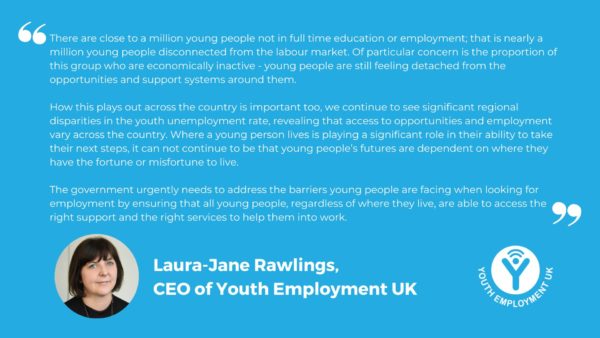The ONS have released the latest Labour Market Overview covering the months of January 2023 – March 2023.
What does this mean for Youth Employment?
The latest labour market overview from the Office for National Statistics shows that the youth employment rate has grown 0.43 percentage points to 11.27%, nearly three times the all-age rate, with 482,000 16-24-year-olds unemployed (including students).
Headlines for young people aged 16-24
In work:
| Employment rate | Employment Level |
| 55.5% (↑0.3%) | 3,798,000 (↑22,000) |
Unemployment:
| Unemployment rate | Unemployment Level |
| 10.27% (↑0.43%) | 482,000 (↑23,000) |
Economically inactive:
| Economically inactive rate | Economically inactive level |
| 37.4% (↓0.6) | 2,561,000 (↓42,000) |
Education:
| In full-time education | Not in full-time education |
| 3,025,000 (↑21,000) | 3,816,000 (↓19,000) |
Worklessness:
| Not in full-time education or employment | |
| 983,000 (↓32,000) | |
| Economically inactive
(not in full-time education) |
Unemployed (not in full-time education) |
| 652,000 (↓39,000) | 330,500 (↑8,000) |
Headlines for all ages
In work:
| Employment rate | Employment Level |
| 75.9% (↑0.1%) 16-64 | 32,995,000(↑45,000) |
Unemployment:
| Unemployment rate | Unemployment Level |
| 3.9% (↑0.1%) | 1,329,000 (↑37,000) |
Economically inactive:
| Economically inactive rate | Economically inactive level |
| 21.0% (↓0.2)16-64 | 8,730,000 (↓62,000) 16-64 |
Commentary
This month’s employment figures show that both the youth unemployment rate and youth unemployment level have grown, both are now at their highest levels since July – September 2021. We are also continuing to see a deeply concerning number of young people who are not in full time education or employment and are economically inactive, accounting for around two-thirds of young people who neither earning or learning. We know that there are long term risks for these young people and their futures, as well as the wider UK economy, if we do not address the barriers they are facing to employment.
CEO, Laura-Jane Rawlings:
“There are close to a million young people not in full time education or employment; that is nearly a million young people disconnected from the labour market. Of particular concern is the proportion of this group who are economically inactive – young people are still feeling detached from the opportunities and support systems around them.
How this plays out across the country is important too, we continue to see significant regional disparities in the youth unemployment rate, revealing that access to opportunities and employment vary across the country. Where a young person lives is playing a significant role in their ability to take their next steps, it can not continue to be that young people’s futures are dependent on where they have the fortune or misfortune to live.
The government urgently needs to address the barriers young people are facing when looking for employment by ensuring that all young people, regardless of where they live, are able to access the right support and the right services to help them into work.”












